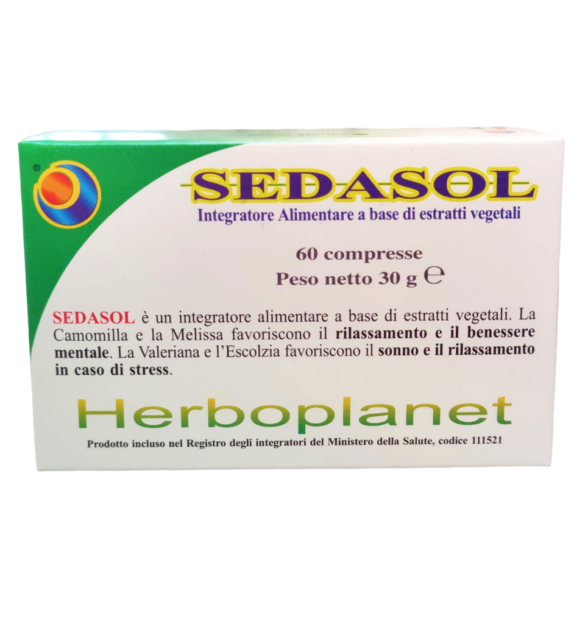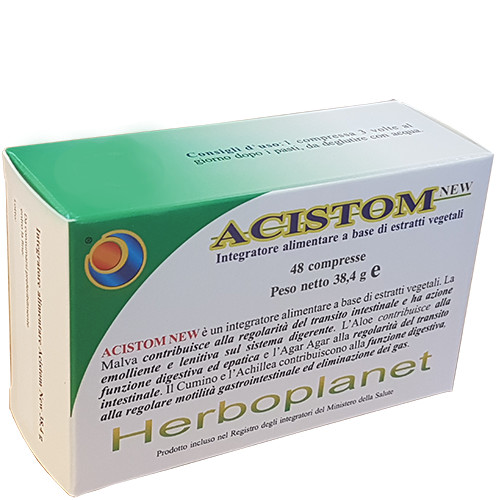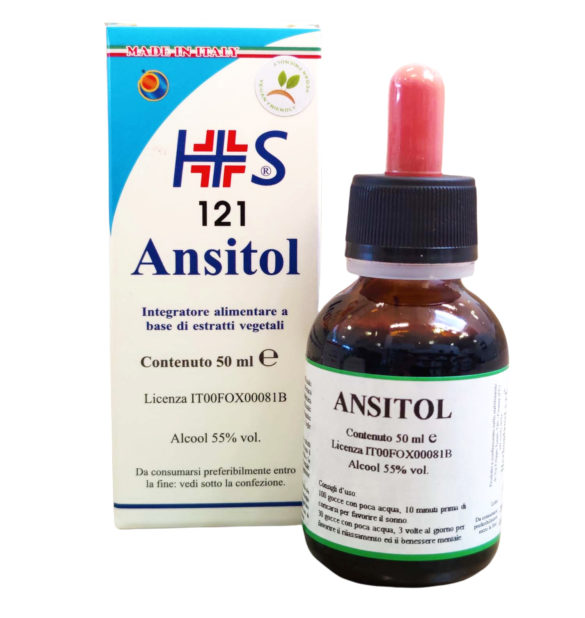CONTRIBUTION OF HERBAL COMPONENTS FOR 4 TABLETS: dry extracts of: chamomile flowers (Matricaria chamomilla L.) standardised to contain 0.8% apigenin 460 mg (apigenin intake 3.68 mg), top of Escolzia (Eschscholtzia californica Cham.) standardised to contain 0.2% in protopine 460 mg (contribution in protopine 0.92 mg), Valerian root (Valeriana officinalis L.) standardised to contain 0.8% in sesquiterpene acids 460 mg (contribution in sesquiterpene acids 3.68 mg). Calcium phosphate, microcrystalline cellulose. Dry extracts of: Melissa leaves (Melissa officinalis L.) standardised to contain 2% rosmarinic acid 120 mg (rosmarinic acid 2.4 mg), Melilot top (Melilotus officinalis Pallas) standardised to contain 0.5% coumarin 100 mg (contribution to coumarins 0.5 mg). Anti-caking agents: vegetable magnesium stearate, silicon dioxide.
GLUTEN FREE – FRIEND OF VEGANS
Product included in the register of supplements of the Italian Ministry of Health, code 10349.
Product included in the register of supplements of the French Ministry of Health, code 2018-5-219.
Product included in the register of supplements of the Belgian Ministry of Health, code PL 1653/3.
SEDASOLis a supplement based on plant extracts.
The CHAMOMILE contributes to relaxation, sleep and mental well-being.
TheESCOLZIA and VALERIANcontribute to relaxation in case of stress and sleep.
The MELISSAcontributes to normal mood.
DIRECTIONS FOR USE: 2 tablets 2 times a day.
NOTES ON SOME PLANTS: CHAMOMILE (Matricaria chamomilla) contains bisabolol, which is protective against gastroduodenal ulcerative lesions and gastritis. Apigenin and its glucosides contained in the plant have a spasmolytic and sedative action to the extent of about three times higher than papaverine. Therefore useful as an anti-inflammatory of the gastrointestinal tract, gastrointestinal spasmolytic and sedative. ESCOLTIA (Eschscholtzia californica) contains alkaloids (protopine, cryptopine and chelidonine) and flavonic glucosides and is the classic phytotherapeutic remedy for insomnia. Instead of disturbing the subject’s behavior, it normalizes his psychological functions. VALERIAN (Valeriana officinalis) contains borneolic esters which give the plant the characteristic sedative action and other glucosidic and alkaloid substances. The pharmacological action of the plant does not depend on a single substance, but on a complex of compounds. Borneol isovalerianate for example, even if it participates only in the biological activity of the drug, is in any case endowed with a weak narcotic power which promotes sleep in nervous subjects by decreasing the excitability of the spinal cord. A notable part of the neurotropic effects of valerian is due to the valeropotriates, which act as sedatives in some forms of agitation and are capable of achieving a sedative effect without depressing the ability to concentrate and the creative faculties. MELISSA (Melissa officinalis) contains essential oil (maximum 0.2%) containing citral, linalool, etc., it also contains flavonoids, triterpenes, polyphenols and tannins; it has relaxing, antispasmodic, nervous tonic properties and promotes the evacuation of gases. The calming effect on the central nervous system is given by citral. The plant has a beneficial effect on morale, it is an effective relaxant in case of anxiety, depression, nervousness and irritability. It decreases emotionality and calms heart palpitations of nervous origin. Melissa is also indicated when anxiety causes digestive disturbances such as indigestion, nausea, colic and gastric dilation. Sweet clover (Melilotus officinalis) has antispasmodic and sedative properties at the visceral level and the central nervous system, these properties are due to the coumarins (active ingredients) contained in it, furthermore, also containing flavonoids, it acts as a diuretic.
BIBLIOGRAPHY:
– Ernesto Riva – “L’universo delle PIANTE MEDICINALI trattato storico, botanico e farmacologico di 400 piante di tutto il mondo” – Ghedina & Tassotti editori s.r.l. – Bassano del Grappa (VI), Maggio 1995.
– Tina Cecchini – Enciclopedia delle erbe medicinali, ………… – DE VECCHI EDITORE
– Padre Gianfranco Lazzari – L’Erbario del Frate – EDIZIONI S. MARCO LITOTIPO
– Alberto Fidi – Erbe e Piante medicinali – FRATELLI MELITA EDITORI
– AA.VV. – Enciclopedia chimica – USES ed., Firenze
– Benigni R., Capra C., Cattorini P.E. – Piante medicinali: chimica, farmacologia e terapia – Inverni della beffa ed, Milano.
– Duraffourd C., D’Ervicourt L., Lapraz J.C. – Cahieres de Phytotérapie clinique – Masson ed., Paris 1983
– Maugini E. – Botanica farmaceutica – CLUSF ed., Firenze 1976
– Pomini L. – Erboristeria italiana – Vitalità ed
– Valnet J., Duraffourd C., Lapraz J.C. – Phytotérapie et aromatherapie – Presse de la Renaissance, Paris 1978
– Massari E. – Erbe in Cina – Milano 1981
– Penso G. – Piante medicinali nella terapia medica – Org. Med. Farm. Ed., Milano
– Enrica Campanili – Dizionario di fitoterapia e piante medicinali – Tecniche Nuove – MI
– Larousse – “Encyclopédie des PLANTES MÉDICINALES identification, préparations, soins” – Larousse-Bordas – 1997
– Tom Wilsons – “Guarire con le erbe, i consigli, le malattie, le ricette, le dosi nella più ricca raccolta di erboristeria” – Fratelli Melita Editori
– Dr. G. Fort – “Guide de traitement par les plantes médicinales et phytocosmétologie, soins de beauté” – Editions Heures de France – Paris, 1976





